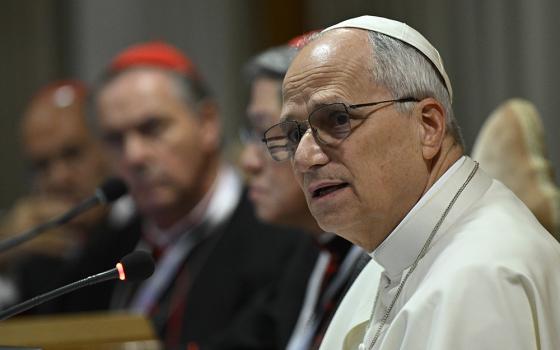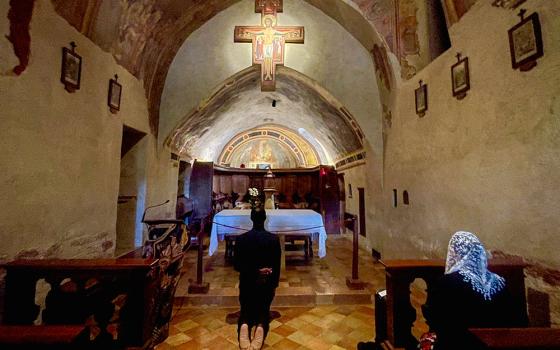Members of the Latino community at Our Lady of Guadalupe in St. Paul, Minn., take part in a procession through the neighborhood and to the church Dec. 11, 2023, on the eve of the feast of Our Lady of Guadalupe. Among the participants was Maribel Rangel, left, who brought two items passed down from her late grandmother: an image of Our Lady of Guadalupe (shown) and the coat she was wearing. Rangel, 24, is a lifelong member of the parish. (OSV News photo/Dave Hrbacek, The Catholic Spirit)
Majority Latino congregations report growth and stability in attendance and, on average, have younger participants, a sharp contrast to the declining attendance and aging congregations in most churches in the United States.
But more than other congregations across the country, Latino faith communities also face significant financial challenges.
The findings from a new Hartford Institute for Religion Research report, released Dec. 12, provide a rare look at the state of Christian churches with a majority population of Latinos.
"Latino congregations, by and large, constitute a more vibrant aspect of congregational life in the United States, particularly Christian congregational life," said the Rev. Kristina Lizardy-Hajbi, author of "Latino Congregations: Trends from the Faith Communities Today (FACT) and Exploring the Pandemic Impact on Congregations (EPIC) Studies."
"They tend to be larger congregations and tend to have younger members and this is, I think, similar to the Latino population as a whole in the United States."
The report notes that Latinos, who comprise 18.7% of the U.S. population, increased by 23% from 2010 to 2020, according to the latest U.S. Census.
Lizardy-Hajbi, a sociologist of religion at Iliff School of Theology, said the report is unique in its look at this topic, which has previously been the subject of case studies and ethnographies.
It breaks down the share of majority Latino congregations, where Latinos are 50% or more of the attendees. The findings indicate that 7 in 10 (71.8%) were evangelical Protestant, while 15.1% were mainline Protestant and 12.8% were Catholic and Orthodox.
However, 6 in 10 Latino congregational worshippers attend evangelical Protestant churches (61.7%), while about one-third are in Catholic churches (33.8%) and only 4.4% in mainline Protestant churches.
Overall, Latino congregations have a median of 80 weekly worship attendees, compared with non-Latino congregations, with a median of 65.
Even as Latino congregations fare better in attendance, they and their leaders struggle more with financial matters.
Advertisement
Overall, giving per capita in Latino faith communities based on average attendance is $1,250, compared with $2,000 for all congregations, the report stated.
Before COVID-19-related lockdowns, 62.7% of these faith communities said their financial health was "excellent" or "good." Afterward, a much smaller percentage — 26.1% — used that description. Those citing "some" or "serious" difficulty shifted in the same time frame from 2.4% to 41%.
"This trend is mirrored across all U.S. congregations, but it is reflected more drastically within Latino faith communities," Lizardy-Hajbi wrote in the 29-page report. "How denominations and other religious bodies are addressing the financial challenges facing Latino congregations most impacted by COVID-19 should be a conversation of priority."
The clergy leading these congregations — 41.7% of whom are Latinos and 40% non-Latino white — often earn their living outside the faith communities they lead. Whether part-time or full-time congregational leaders, more than a third have paid employment beyond their congregation. Two in 10, overall, are not paid for their congregational work.
Majority Latino congregations are half as likely (34.7%) to own the facilities where they meet than are non-Latino congregations (64.8%).
Owning, rather than renting, a facility may allow a congregation to better serve as a hub for the community, said Lizardy-Hajbi.
The report noted that half (50.2%) of majority Latino congregations put "a lot" of emphasis on community service, while 33% of other congregations do.
It also described a mix of success in congregational growth. About 4 in 10 (43.6%) saw attendance grow more than 5% in the last five years, while 18.2% remained fairly stable and 38.2% saw a decline of more than 5%.
"Still, the overarching picture for majority Latino congregations looks more promising than for other congregations; but time will tell whether dynamics of increasing non-affiliation and secularism will ultimately impact these faith communities," Lizardy-Hajbi stated in the report.
The findings are based on a segment of research from the FACT survey of 15,278 congregations in 2020 and 2,074 responses to the EPIC survey conducted in 2021. The majority Latino congregations totaled 276 (1.8%) and 30 (1.4%), respectively.






